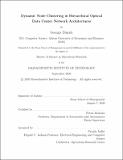Dynamic node clustering in hierarchical optical data center network architectures
Author(s)
Dimaki, Georgia.
Download1227095606-MIT.pdf (1.576Mb)
Other Contributors
Massachusetts Institute of Technology. Operations Research Center.
Advisor
Eytan Modiano.
Terms of use
Metadata
Show full item recordAbstract
During the past decade an increasing trend in the Data Center Network's traffic has been observed. This traffic is characterized mostly by many small bursty flows (mice) that last for less than few milliseconds as well as a few heavier more persistent (elephant) flows between certain number of nodes. As a result many relatively underutilized network links become momentarily hotspots with increased chance of packet loss. A potential solution could be given by Reconfigurable Optical Data Centers, due to higher traffic aggregation links and topology adaptation capabilities. An example is a novel two level hierarchical WDM-Based scalable Data Center Network architecture, RHODA, which is based on the interconnection of high speed equal sized clusters of Racks. We study the traffic based dynamic cluster membership reconfiguration of the Racks. Main goal is to maintain a near optimal network operation with respect to minimization of the inter cluster traffic, while emphasising better link utilization and network scalability. We present four algorithms, two deterministic greedy and two stochastic iterative, and discuss the tradeoffs of their use. Our results draw two main conclusion: 1) Stochastic iterative algorithms are more suitable for dynamic traffic based reconfiguration 2) Fast algorithmic deployments come at a price of reduced optimality
Description
Thesis: S.M., Massachusetts Institute of Technology, Sloan School of Management, Operations Research Center, September, 2020 Cataloged from PDF version of thesis. Includes bibliographical references (pages 127-134).
Date issued
2020Department
Massachusetts Institute of Technology. Operations Research Center; Sloan School of ManagementPublisher
Massachusetts Institute of Technology
Keywords
Operations Research Center.